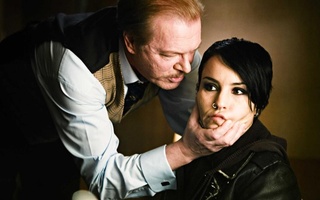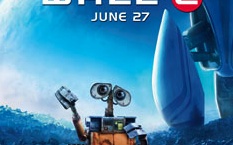
Astrid (voiced by America Ferrera) hangs for her life in Dean DeBlois and Chris Sanders’ “How to Train Your Dragon.” The film tells the story of Hiccup (Jay Baruchel), a boy who chooses to train, rather than hunt, dragons.
The inhabitants of Berk do not lead particularly reflective lives. It’s hard to when one resides in a Viking village that is constantly being raided by hordes of dragons. Considering whether there are ways other than violence to approach this situation is not something that occurs to them. “How to Train Your Dragon,” based on the Cressida Cowell book of the same name, is the story of what happens when one boy comes up with an alternative solution to the town’s troubles. Thankfully, it’s also a movie in which the characters and script compensate for a formulaic plotline.
The hero of the film is the unfortunately named Hiccup (voiced by Jay Baruchel), who is the son of the stoic village chieftain, but inheritor of none of his physical prowess or impressive musculature. A thoughtful, contemplative sort, Hiccup does not quite fit in at dragon-slaying boot camp, where the motto is “Why read words when you can just kill the stuff the words tell you about?” This attitude is problematic for Hiccup, who has secretly befriended a dragon he has christened Toothless—a creature whose creepy cuteness is strikingly similar to that of Stitch from “Lilo and Stitch” (a film that happens to be written by Dean DeBlois and Chris Sanders, the co-writers and directors of “How to Train Your Dragon”).
Toothless is but one of many creatively crafted dragons in the film. Unlike the CGI-based cinematography, which often calls to mind the epic sweep of Peter Jackson with glorious pans across its digitized landscapes, the film’s dragons are awkward and strange. With outsized heads and teeth that jut out at uncomfortable angles, these are not the majestic and mysterious beasts of so many other films-—they are odd and misshapen, just like people. The movie’s message of empathy is thus underscored by its imagery.
But despite its feel-good message of cross-species acceptance, the movie is far from lacking in some good old-fashioned dragon mashing. Of course, it’s the sort of PG mayhem in which everything on the screen is spectacularly immolated except, conveniently, the people. Apparently, the dragons of “How To Train Your Dragon” are really bad with moving targets—perhaps that’s where the training comes in. But suffice to say, Hiccup’s efforts at human-dragon reconciliation do not go over as smoothly as he hoped.
For all the CGI bombast, though, what carries “How to Train Your Dragon” is the dialogue written for its characters and handed off to a superb cast. Baruchel plays the self-deprecating misfit Hiccup as though he’s talking to the audience, and not the characters on the screen. In this way, he pulls the viewer into his confidence, and both find themselves the only sane people in a village of blood-crazed Vikings.
The secondary cast, including Gerard Butler (as Hiccup’s dad, Stoick) and America Ferrera (as tomgirl Astrid, whom Hiccup wins over), acquit themselves admirably. Perhaps the most inspired supporting performance comes from the ever-dependable Craig Ferguson, who voices Hiccup’s mentor Gobber, a character who says everything mentor characters are never supposed to say in movies, thus providing some of the film’s best laughs. At one point, when Hiccup complains how he can’t help that he wasn’t born with the beefy physique of his father, Gobber helpfully explains “It’s not what’s outside that he dislikes—it’s what’s inside he can’t stand.”
All this character work pays off. The movie never feels like watching someone else play a video game. Instead, “How to Train Your Dragon” takes a classic and clichéd Hollywood storyline and makes it memorable. This is most evident in the wondrous scenes in which Toothless, Hiccup, and Astrid soar through the sunset to the beautiful Celtic-inspired score of John Powell. Viewers may recall a very similar CGI experience in “Avatar,” in which flying beasts streak the sky in symbiotic unity with their mounted protagonists. The difference in “How to Train Your Dragon” is that the audience actually cares about the characters and not just the images. What it lacks in beauty, it makes up for in humanity.
—Staff writer Yair Rosenberg can be reached at yrosenb@fas.harvard.edu.
Read more in Arts
‘Machine’ Fails to Add Up to SuccessRecommended Articles
-
 Welcome to the Dungeon
Welcome to the Dungeon -
 The Girl with the Dragon Tattoo
The Girl with the Dragon Tattoo -
 Studying with Movie Scores
Studying with Movie Scores -
 Women's Basketball Ends Season with Loss to Drexel
Women's Basketball Ends Season with Loss to Drexel -
 K-Pop Wages Coup D’état
K-Pop Wages Coup D’état -
Singles RundownDrake's anthem "All Me" is a "Nothing Was The Same" standout, Mike WiLL Made-It's new track "23" features a questionable Miley Cyrus rap verse, and Imagine Dragons get psychedelic with their one-off single "Monster."













